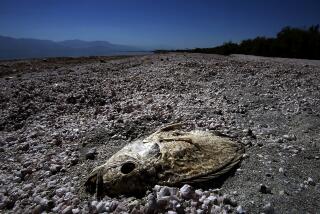Salt room therapy on shifty ground
- Share via
It’s 1 o’clock on a Tuesday afternoon, and Heidi Kling is reading in an all-white room. She’s shoeless, but socks protect her feet from the 6 inches of salt that cake the floor. The only objects in the windowless room are four chaise longues and hand-molded plaster icicles that hang from the ceiling. If there were a Yeti in the room, you would swear you were on the Matterhorn at Disneyland.
Normally, Kling would be at work or running errands, but today her allergies, which cause her ears to ring, have brought her to this monochrome sanctuary.
Basking in salt rooms, also known as halotherapy, is an alternative therapy for people with chronic respiratory and skin problems that is modeled after the salt caves and spas that originated in Eastern Europe more than 200 years ago. In the last decade, the trend has caught on, and facilities have opened up in Israel, Canada, New York, New Jersey, Chicago, Florida and, most recently, Encino, home of the Salt Chalet, the first salt room treatment center on the West Coast.
But though salt rooms may be garnering fans, health experts are leery of the medicinal benefits that these rooms are purported to provide. Stories about miraculous recoveries and unprecedented health improvements are all over the Web, said Dr. Dean Schraufnagel, professor of medicine at the University of Illinois at Chicago. That doesn’t guarantee they’re true. “There haven’t been any clinical studies that research this particular therapy method,” he says.
Tucked away in a shady corner on the second floor of Encino Commons, an outdoor shopping center most notable for cameos in the movie “The 40-Year-Old Virgin,” the Salt Chalet is hardly noticeable in the shadow of a Bed, Bath & Beyond and a Bally Total Fitness center.
For $55 a pop, clients relax in rooms with salt-caked walls and floors. A small hole in the wall hides the pièce de résistance of the whole shebang — a generator spewing out 1/2 cup of Dead Sea salt for every 45-minute session. As customers sit, relax and breathe, they are presumably inhaling and coming into contact with this supposedly therapeutic salt.
The Salt Chalet consists of three salt rooms — two for adults and one for children. Brightly colored shovels, buckets and toy trucks litter the salt-strewn floor of the children’s room, while adults have the option to watch television, listen to music, read a book, talk to other clients in the rooms or dim the blue-hued lights and sleep.
“Everybody does their own thing when they’re in the room,” says proprietor Dikla Kadosh, who opened the facility nine months ago with her husband, David.
Patty Adams, an accountant from San Diego, commutes to the Chalet once a week for two back-to-back sessions, booking the private adult room so she can recline without embarrassment in a bikini while listening to her iPod. She has a skin condition, psoriasis guttate, that causes red, raised lesions on much of her body during flare-ups, and she’s not comfortable revealing her skin in public.
“I like to go in with as much skin exposed so that every part of me can get a bit of the salt.” She says she has seen great improvements in her condition since she started coming to the salt room (her only other medication is antibiotics).
“My skin has finally cleared up, and I’m not embarrassed to show my arms,” she says, pointing to a faded pink sore.
Adams says she learned about salt rooms from an article published earlier this year in the Jewish Journal’s Tribe magazine. That coverage, as well as publicity that it has received from KCAL Channel 9’s local news, LA Talk Radio and the daytime television series “Doctors,” has helped widen Salt Chalet’s customer base, occasionally attracting clients from as far away as Washington state.
But, Schraufnagel says, though it’s true that inhaling salt solutions can help treat common dust and seasonal allergies and reduce congestion in patients with cystic fibrosis by clearing up mucus, “this does not mean that salt rooms can do the same thing.”
Saline solutions administer salt to the body in a more direct way than salt rooms do, Schraufnagel notes. The solution is squirted into the nostrils, quickly and efficiently transporting salt of a specific particle size to the lungs and chest cavity.
What’s more, the particle size of the salt in the solution is probably more predictable and uniform, as well as smaller, than those emitted from a salt room generator. Though the size of the particles in the air of the salt rooms is unknown, they’re probably too large to be easily inhaled, Schraufnagel says — as evidenced by the fact that some customers say the particles are large enough to be seen as they shoot out of the machine.
“To get into your lungs, the particles need to be very small,” he says, “between 1 to 5 microns in diameter.... A salt room wouldn’t be as effective as the mist from an inhaler for people with asthma or a saline solution for people with sinus or allergy problems.”
Dr. Mark Lebwohl, chairman of the dermatology department at Mount Sinai School of Medicine in New York, agrees that the benefits of salt room therapy are as yet unproven, but adds that he understands how halotherapy has become popular.
Many salt rooms, including the Salt Chalet, use salt imported from the Dead Sea. Because of the sea’s unique properties — it is the lowest point on Earth and has the highest concentration of minerals in a body of water — many people swear that its components (salt, mud and water) can treat a variety of ailments, Lebwohl says, especially skin conditions.
That hype is probably undeserved, he says: In truth, it may mostly be the sunlight that makes the Dead Sea experience therapeutic. The spot is more than a quarter mile below sea level, and as sunlight travels through this extra depth of air, many of the sun’s damaging short-wavelength UV rays are filtered out.
In a 1996 study of 81 people with psoriasis at a Dead Sea spa, Israeli researchers found that after four weeks, the condition improved in 28% of those people who bathed in Dead Sea water, but of those who only sunbathed there, 73% saw results. Improvement was seen in 83% of those who both sunbathed at the spa and went in the water.
Dr. Neil Kao, an assistant professor of medicine at the College of Medicine at the University of South Carolina, says that if salt rooms are as effective as people claim they are, then one would expect to see similar health improvements from other salt-related activities.
“[Why would it] be different from … swimming in the ocean and swallowing salt water?” he said.
Regardless of doubts and the lack of studies, the salt-room trend appears to be slowly on the upswing. “In the last few years, six salt room centers have been built in the U.S., most within the last few months,” Dikla says. She expects to see at least one additional salt room on the West Coast by the end of this year.
And if nothing else — well, the sessions are relaxing.
When her 45-minute session is up, Heidi Kling clicks off her iPod and takes a deep, cat-like stretch as she wakes up her body. “I’m not normally able to take naps in the day, but when I come here … I can’t help myself. I don’t know if these sessions are doing anything to help my allergies just yet, but I’m going to keep coming here in the hopes that they do.”


